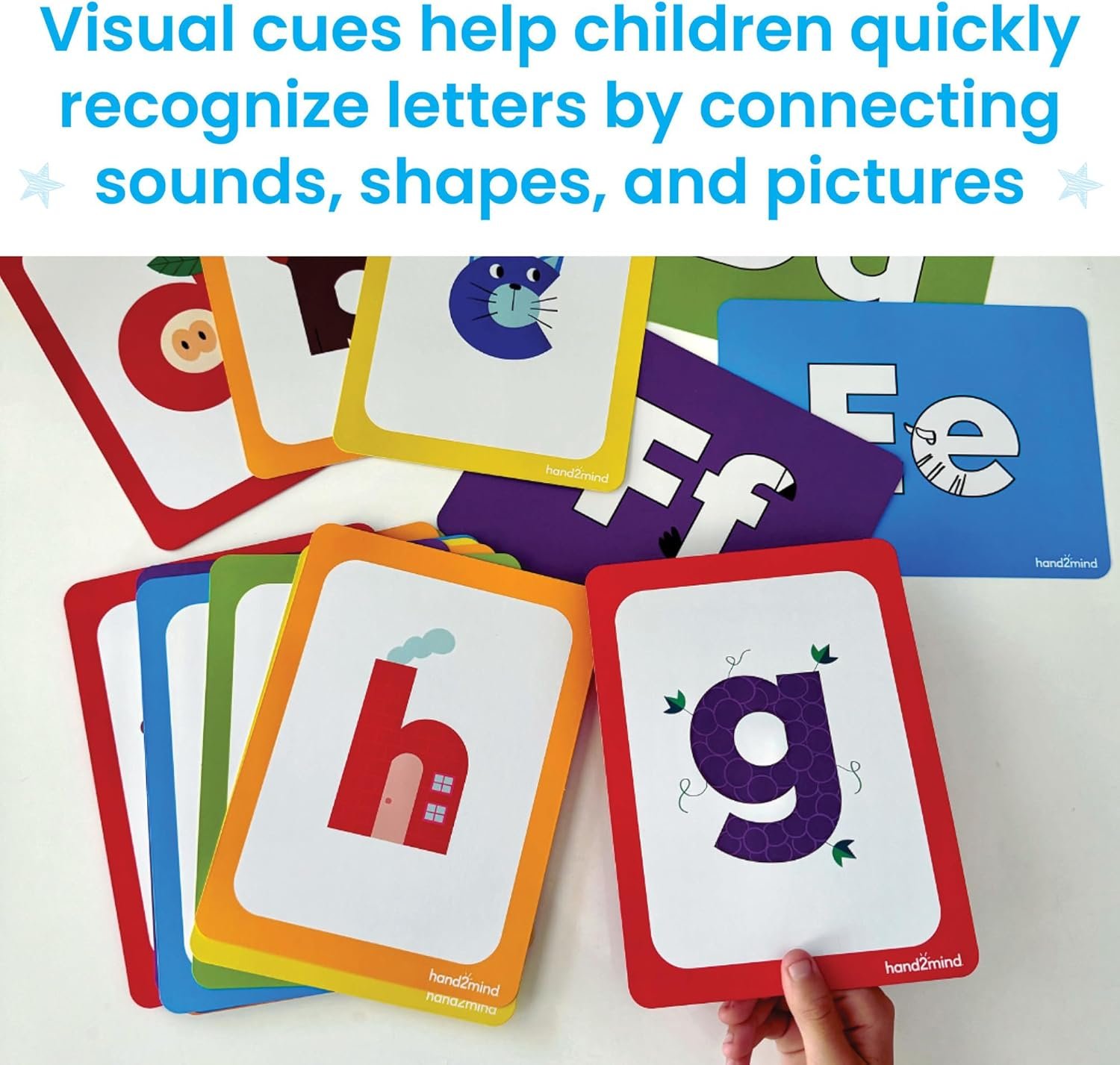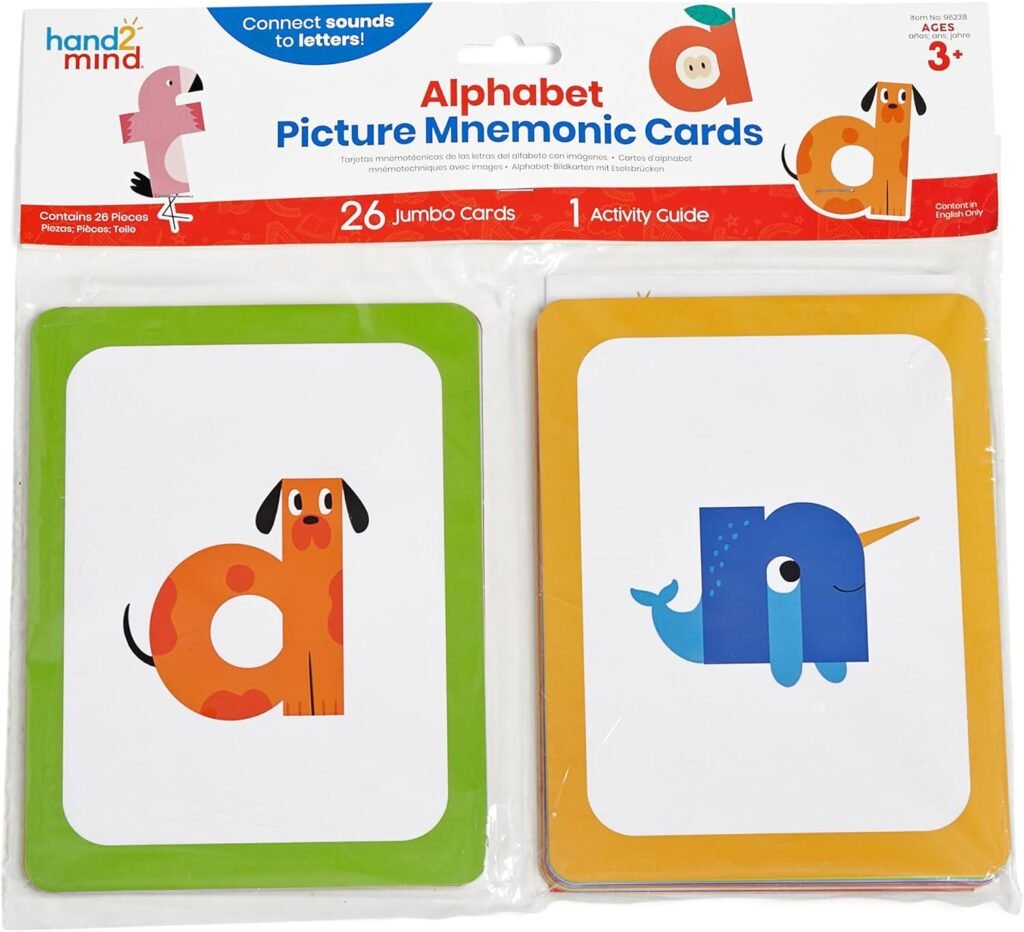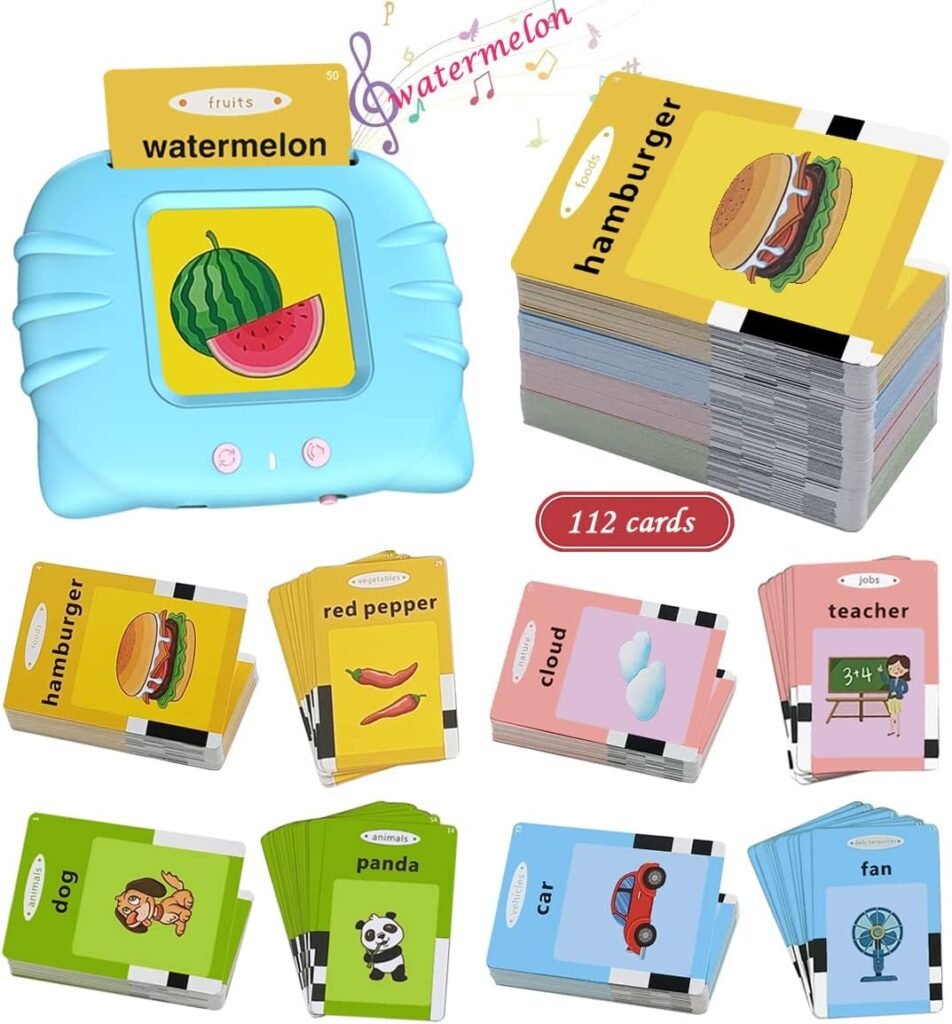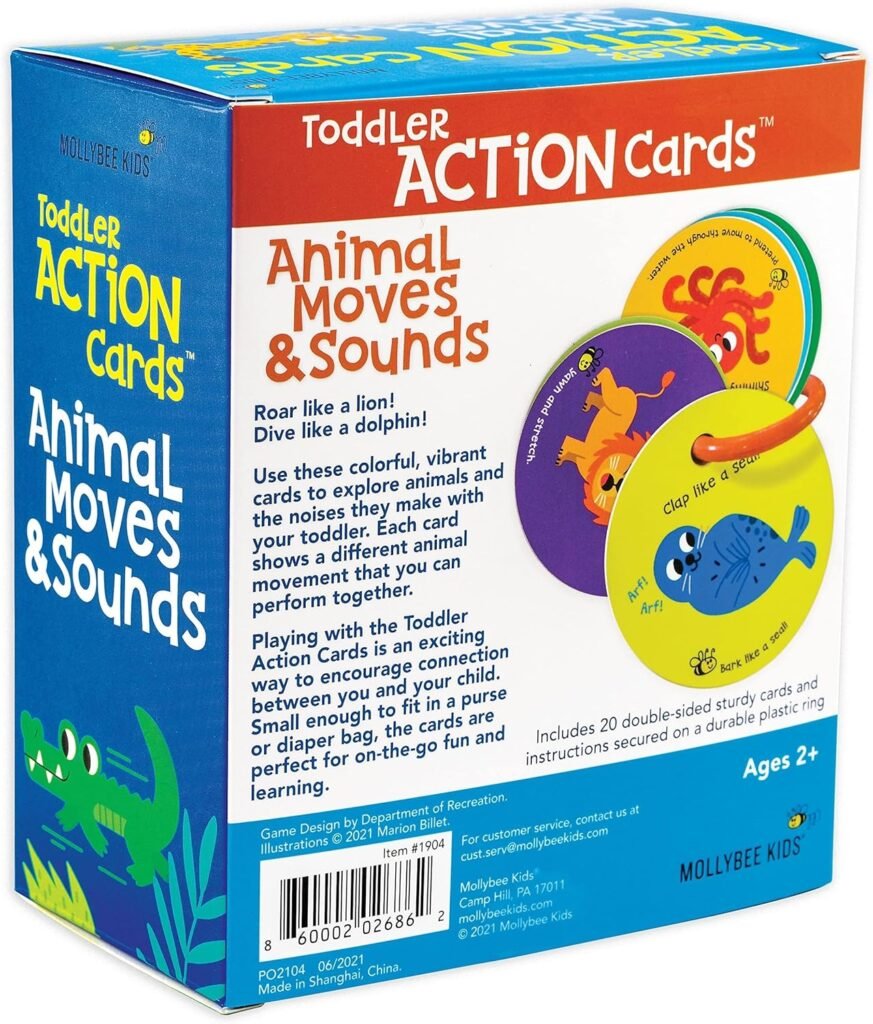As I scrolled through the endless aisles of online learning toys, I couldn’t help but feel a mixture of nostalgia and excitement. It’s amazing to think how far we’ve come since my own childhood days of learning the alphabet with nothing more than a chalkboard and the occasional apple. These days, we have delightful products like hand2mind Alphabet Picture Mnemonic Cards and MOLLYBEE KIDS Toddler Action Cards that make learning not just educational, but also a whole lot of fun—and if you haven’t tried them yet, you’re in for a treat!
The history of educational products aimed at young learners is as rich as a well-baked chocolate cake. We’ve moved from mere flashcards to interactive activities designed to engage little ones in multiple ways. Cards and toys that prompt letter recognition, animal movements, or even sight words help present learning as an adventure rather than a chore. The benefits of having these tools in a home or classroom are numerous; they can bolster memory, enhance communication skills, and even provide therapeutic benefits for children with special needs, like those on the autism spectrum. They transform the daunting experience of learning into a playful exploration of knowledge.
In this article, I’ll carefully examine the hand2mind Alphabet Picture Mnemonic Cards and MOLLYBEE KIDS Toddler Action Cards, comparing their features and what makes them tick. So grab a snack—preferably something which isn’t crumbled all over the couch, unless you’re a fan of the crumbly texture—with your little one beside you, and let’s jump into the world of educational toys made for little hands and curious minds!
Hand2Mind Alphabet Picture Cards – ABC Flashcards for Kids and Classroom Use, Early Learning, Letter Recognition, Montessori Activities
When diving into the realm of toddler learning tools, I often find myself overwhelmed with the choices available. However, one gem that stands out for me is the hand2mind Alphabet Picture Mnemonic Cards. These flashcards are designed with a clear educational purpose and captivating features that make learning the alphabet an enjoyable experience for my little one.
The primary use of these cards is straightforward: to facilitate letter recognition and phonics for toddlers. Each card displays a lowercase letter accompanied by an engaging picture that corresponds to the sound the letter makes – for instance, the letter “a” is paired with an image of an apple. This outstanding use of mnemonics not only helps my child remember the letters but also aids in their auditory learning by associating sounds with visual cues. The cards are effective for both at-home learning or as a component in a classroom setting, proving versatile for various learning environments.
One of the reasons I gravitate towards the hand2mind Alphabet Picture Mnemonic Cards is their interactive approach to learning. As a parent, I appreciate any product that invites my toddler to engage rather than merely memorize. The clever integration of pictures with letters sparks curiosity and allows for deeper connections, making learning feel less like a chore and more like a playful experience.
Since I’m a proponent of Montessori methods and principles, these cards align perfectly with my educational philosophy. They promote independent learning, where my child can explore the cards at their own pace while also allowing me to join in the fun! They’re a great resource to have in my educational arsenal, encouraging innovative and hands-on learning.
The hand2mind Alphabet Picture Mnemonic Cards have a clear educational objective: to provide toddlers with the foundational skills necessary for literacy. Here are some key features that caught my attention:
-
Double-sided cards: Each card presents both uppercase and lowercase letters, allowing for gradual learning. The front features the lower-case letter and its corresponding picture, while the back presents both forms of the letter with a visual reference from the front. This seamless transition supports my child’s development and builds confidence as they progress.
-
Jumbo size: I adore that these cards are designed to be jumbo-sized (6″ x 8″), making them comfortable for little hands to grip and manipulate. Their size also ensures they’re easily visible, whether we’re using them at home or in a classroom setting.
-
Colorful and engaging: The vibrant colors and playful illustrations make the cards visually appealing. My child is naturally drawn to colorful imagery, and these cards capture their attention effectively.
-
Activity Guide: Included with the cards is an Activity Guide that offers a variety of activities centered around letter recognition, phonics, and word-building. This guide is particularly helpful for me, as it provides structured learning games that keep my child engaged while promoting the development of essential skills.
In terms of overall quality, I must say I’m very impressed. The material of the cards feels sturdy and durable, which is essential when dealing with toddlers, who can sometimes be a bit heavy-handed. They endure multiple usage sessions without significant wear or tear, making them a worthwhile investment not just for now, but for future siblings or playdates as well.
The vibrant colors have remained intact even after numerous interactions with my child, showcasing the high-quality printing and materials used. It’s clear that hand2mind has created a product that not only serves its educational purpose but does so with excellent craftsmanship.
Like any product, the hand2mind Alphabet Picture Mnemonic Cards do come with their own set of advantages and a few minor considerations.
-
Engaging design: The integration of pictures with letters creates a delightful and memorable learning experience.
-
Versatile: Suitable for both home and classroom settings, these cards adapt beautifully to a variety of educational environments.
-
Durable: High-quality materials ensure the cards can withstand the rigors of toddler play.
-
Comprehensive: The included Activity Guide provides welcome structure and additional learning opportunities.
-
Encourages literacy: By supporting letter recognition and phonics, these cards set a solid foundation for future reading skills.
-
Limited scope: While focusing primarily on alphabet recognition is essential, some may find that the cards only cover basic letters without extending into more complex phonics or reading skills.
-
Size considerations: Although I love the jumbo size for visibility, some parents might find that the larger cards take up more space than they would prefer for storage.
In my experience, the hand2mind Alphabet Picture Mnemonic Cards have proven to be an invaluable addition to my toddler’s learning journey. They create a colorful, interactive way for young children to absorb essential language skills while blending playfulness with education. Whether you’re a parent looking to enhance your child’s learning at home or an educator seeking effective tools for the classroom, these cards can foster a joyful learning atmosphere. Ultimately, I find that anything that sparks curiosity and excitement in my child’s learning process deserves a spot in their educational toolkit.
Talking Flash Cards for Toddlers (Ages 2-4), 224 Sight Words, Speech Therapy and Sensory Toy, Educational Gift for Boys (Blue)
When it comes to fostering my toddler’s love for learning, I’m always on the lookout for fun and engaging educational tools. One product that caught my eye is the Talking Flash Cards for Toddlers, designed for children aged 2 to 4 years. This compact device combines technology with traditional learning, making it a great addition to any child’s educational toolkit.
The primary use of these talking flash cards is to enhance vocabulary and cognitive skills in toddlers. With 224 sight words to choose from—including common themes like food, colors, and shapes—this learning tool provides an interactive experience. The idea is simple: by inserting a flashcard into the device, the child can hear the word pronounced along with the associated sound. This not only captures their attention but makes learning through play a reality.
What I particularly love about the Talking Flash Cards is how they cater to diverse learning needs. Whether my child is a hands-on learner who thrives on exploration or they need additional support for speech development, this tool meets various educational goals. I genuinely appreciate that it doesn’t use screens, letting my child engage in learning without the distractions typical of digital devices.
Additionally, the bilingual feature is quite impressive, as it offers both English and Chinese language options, giving my child an early introduction to another language.
The purpose of these talking flash cards is two-fold: to provide a fun and interactive way for children to learn simple words and to assist children who may be experiencing speech delays. Here are some key features that showcase its value:
-
112 Sight Words: The set includes a variety of sight words categorized into ten themes, allowing kids to explore learning from multiple angles.
-
Interactive Learning: When a child places a card in the device, it not only announces the word but also simulates related sounds. This multisensory approach supports vocabulary retention.
-
Speech Therapy Support: For parents concerned about their child’s speech development, this tool allows for interactive play that can stimulate language skills.
-
Eye Protection Design: The most innovative aspect of this product is its screenless design, which is essential for reducing screen time and protecting children’s eyes.
-
Durable and Safe Materials: Made from ABS plastic with smooth edges and non-toxic paint, I feel confident that this product is safe for my child. Its compact size (2.3×3.5 inches) fits perfectly in small hands, promoting independent play.
-
Bilingual Options: This feature not only encourages learning in English but also introduces a second language early in life, something that’s beneficial in a globally connected world.
When assessing overall quality, I find that the Talking Flash Cards really stand out in several respects. The design of the device is both cute and practical; it captures my toddler’s attention while being easy to use. The sound quality is impressive, allowing the pronunciations and sounds to come through clearly without being too loud or distracting.
Moreover, the rechargeable battery and auto power-off feature mean I don’t have to constantly change batteries—just plug it in, and we’re good to go! The adjustable volume control is also a thoughtful touch, enabling me to set it to a comfortable level for home use without disturbing others.
Like any product, the Talking Flash Cards for Toddlers has its strengths and weaknesses.
-
Interactive Learning: The combination of audio and visual elements keeps toddlers engaged.
-
Speech Development Support: Great for children who may struggle with communication.
-
Portable: Its compact size makes it easy to take on trips or during playdates.
-
Durable Design: Made from high-quality materials that withstand wear and tear.
-
Bilingual Capability: Early exposure to another language is a huge plus.
-
Limited Range of Words: While 224 words are included, some parents may wish for a broader vocabulary set.
-
Requires Adult Supervision: Younger toddlers might need help inserting cards, although this can be a great bonding moment.
-
Charge Duration: Though USB charging is convenient, some users may find the battery life shorter than expected during extended play sessions.
In my experience, the Talking Flash Cards for Toddlers is an engaging educational tool that provides essential learning opportunities while promoting speech development. It’s versatile enough to cater to various developmental stages, and my child absolutely enjoys interacting with it. With its thoughtful design and high-quality materials, this product has truly become a staple in our toddler learning collection.
As we navigate the exciting educational journey together, I’m thrilled to have this tool in my toolkit, ensuring that learning is not only effective but also joyfully interactive!
Mollybee Kids Animal Action Cards for Toddlers, Ages 2+
As a parent, I’m always on the lookout for fun and engaging ways to support my toddler’s learning journey. One product that has quickly become a favorite in our household is the MOLLYBEE KIDS Toddler Action Cards Animal Moves and Sounds. These delightful cards have provided a great blend of play and learning, making it easy for me to bond with my little one while introducing the wonderful world of animals.
The primary use of these action cards is to encourage toddlers to explore both physical activities and sound recognition through imaginative play. Each card features a vibrant illustration of an animal and describes a specific action or sound that my child and I can try out together. It transforms what could be a passive learning experience into an active, participatory one—so it’s an excellent tool for parents who want to keep their toddlers moving and engaged!
What I love most about the MOLLYBEE KIDS action cards is how they turn learning into a fun, interactive activity. I appreciate products that involve physical movement because they help my child develop gross motor skills while enhancing cognitive understanding. Plus, these cards are a great travel companion. Whether I’m going to the park or running errands, I can easily toss them in my bag for some impromptu learning.
The purpose of the MOLLYBEE KIDS Toddler Action Cards is to spark joy in learning through imaginative play. With 20 double-sided cards, each card showcases a distinct animal along with an associated action or sound, making it easy for toddlers to imitate. They’re designed for children ages 2 and above, and, importantly, they’re small enough to fit in a diaper bag or purse.
Some key features include:
- Charming Illustrations: My toddler loves the bright and inviting artwork, which makes the animals easily recognizable.
- Interactive Actions: Each card encourages toddlers to perform specific movements or sounds, laying the groundwork for kinesthetic learning.
- Versatile Playability: The cards are not only for the specified actions; I can easily add our activities or questions to extend the fun and reap more learning benefits.
- Portable Size: The cards measure 3.5 inches across, making them just the right size for little hands to hold and manipulate—and perfect for family outings.
When it comes to overall quality, I can say I am truly impressed. The cards are designed to withstand the wear and tear of toddler play. Made from durable materials, I no longer have to worry about them ripping or bending too easily. After multiple play sessions, they still look as good as new—if anything, my toddler just loves them more!
Not only are the illustrations vibrant and engaging, but the cards also feel sturdy in my hands. I appreciate that I can rely on their durability during lively playtime with my toddler, which speaks volumes about the thought and care put into the design.
Every product has its ups and downs, and the MOLLYBEE KIDS Toddler Action Cards are no exception. Here’s a breakdown of the pros and cons based on my experience:
-
Engaging Learning Tool: The combination of movement and sound keeps my toddler interested and eager to participate.
-
Promotes Imagination: These cards encourage creative play, allowing both parent and child to think outside the box regarding actions and sounds.
-
Easy to Store and Carry: I love how they fit snugly in my bag, allowing us to take our learning adventures anywhere.
-
Encourages Parent Interaction: The cards provide numerous opportunities for me to bond with my child and actively engage in their learning.
-
Versatile Activities: I can easily modify or expand upon the suggested actions for varied experiences each time we play.
-
Limited Number of Cards: While 20 cards are a good start, I sometimes wish there were more options to keep things fresh and exciting.
-
Age Specificity: Designed for ages 2 and up, younger toddlers who may lack the fine motor skills or understanding of the concepts may need extra guidance, which could be a hurdle for some parents.
The MOLLYBEE KIDS Toddler Action Cards Animal Moves and Sounds have seamlessly integrated learning and play into our daily routine. They are easy to use, aid in development, and most importantly, create joyful experiences between my toddler and me. If you’re in search of activities that will keep your little one engaged and excited about learning, these cards could be just what you need!
Comparing the Learning Tools for Toddlers: A Personal Analysis
As a parent, I often find myself caught in an overwhelming web of educational products that promise to enhance my child’s learning experience. In my quest for the perfect blend of fun and education, I’ve stumbled upon three intriguing products: hand2mind Alphabet Picture Mnemonic Cards, Satxtrem Talking Flash Cards, and Mollybee Kids Action Cards. Each of these tools holds its unique charm and merits, but how do they truly stack up against one another? Let’s dive in, shall we?
Specifications Breakdown
| Feature | Hand2mind Alphabet Picture Mnemonic Cards | Satxtrem Talking Flash Cards | Mollybee Kids Action Cards |
|---|---|---|---|
| Size of Cards | 6″ x 8″ | 2.3″ x 3.5″ | 3.5″ x 3.5″ |
| Number of Cards | 26 double-sided cards + 1 activity guide | 112 sight word cards | 20 double-sided cards |
| Learning Areas | Alphabet recognition, phonics | Vocabulary development | Animal actions and sounds |
| Interaction Type | Visual and tactile | Audio with visual cues | Kinesthetic and auditory |
| Age Range | 2-4 years | 1-6 years | 2+ years |
| Material Safety Features | Environmentally friendly | 100% safe, smooth edges | Not specified |
| Additional Features | Classroom display-friendly, activity guide | USB charging, bilingual options | Portable, role-playing ideas |
A Closer Look
Hand2mind Alphabet Picture Mnemonic Cards
Imagine my delight when I found these colorful, jumbo-sized cards that just scream “pick me up and learn!” Each card comes with a delightful picture to help kids associate sounds with letters. It’s like a mini art show, but educational! Plus, the back provides uppercase letters for those ready to level up their skills. I appreciate that teachers can easily display these in classrooms, making learning a community affair.
Satxtrem Talking Flash Cards
Next up, the Satxtrem Talking Flash Cards beckoned with their promises of sound-based learning. I mean, what’s not to love about a machine that talks back? As I inserted the flashcards into the gadget, I marveled at how it not only verbalizes words but does it with a charming flair, making vocabulary building a delightful auditory experience. It’s also designed for children with speech delays, which genuinely warms my heart. The compact size means I can toss it in my bag and take it on my adventures—so, bonus points for portability!
Mollybee Kids Action Cards
Lastly, the Mollybee Kids Action Cards pulled at my heartstrings as they offer a unique twist on movement-based learning. Each card is like a mini invitation to act out sounds and motions, making it more than just a sitting-and-learning experience. Perfect for those hyperactive kiddos who thrive on kinetic energy! They’re also a nice size for on-the-go entertainment, making them ideal for playdates and family outings.
Final Thoughts
Each product has its strengths and weaknesses. If I want my child to develop letter recognition in a visually stimulating way, the hand2mind cards are my go-to. When focusing on expanding vocabulary through interaction, the Satxtrem flash cards win me over. If we’re seeking active play and creativity, I’d reach for the Mollybee action cards.
In this age of endless educational gadgets, I’ve found that understanding my child’s specific needs is key to making the right choice. Whichever way I lean, I feel optimistic knowing that with these tools, I’m on the right path to sparking a love for learning in my little one. Now, if only someone could teach me how to stay organized while managing these delightful distractions!
Wrapping It Up: A Review of Educational Toys for Little Learners
After diving into these three delightful educational products, I must say, I’m a bit smitten with the idea of turning learning into a playful endeavor for toddlers. Each offers its unique flair and function, which makes my heart flutter like a child seeing a colorful piñata. But, of course, no product is without its quirks. So, let’s unpack my thoughts.
Hand2mind Alphabet Picture Mnemonic Cards
First up, we have the hand2mind Alphabet Picture Mnemonic Cards. These cards blend vibrant imagery with letters that just scream “pick me up!” They’re perfect if you’re looking to boost letter recognition in those adorable little brains. I mean, who doesn’t want their kid to ace the alphabet? However, I did find some of the pictures a bit abstract—like, why does the letter “B” have a picture of a butterfly? A bit confusing, right? Still, I’d recommend these to parents aiming to incorporate a Montessori approach into their learning environment, especially with kiddos aged 2 to 4.
224 Sight Words Pocket Speech Therapy Cards
Next, we have the 224 Sight Words Pocket Cards. I initially thought these were for advanced readers, but let’s be real; if your toddler can recite “ABC” with gusto, they can definitely tackle some sight words too. These cards double as therapy tools, which is fabulous for all kids, including those with sensory needs. The only hitch? The pocket size can be a bit cumbersome for little hands, making them prone to getting lost faster than a sock in the washing machine. I’d say, if you have preschoolers with special learning needs or if you’re just keen to get an early start on literacy, these cards are worth a shot!
MOLLYBEE KIDS Toddler Action Cards
Lastly, let’s talk about the MOLLYBEE KIDS Toddler Action Cards. Action-packed, these cards are anything but sedentary! Perfect for kids bursting with energy, they encourage movement and physical engagement—something I wish all learning materials would do. However, the instructions could be clearer; what toddler reads directions? I’d recommend these cards for parents looking to channel their child’s wildness into a fun and interactive learning experience, especially for the little ones who might be diagnosed with ADHD or those just needing to wiggle a bit.
My Takeaway
So, here’s the scoop: if you’re a parent or caregiver with a toddler in your midst, these three products could be absolute game changers for blending playtime with education. Each has its strengths and a few quirks too, but let’s be real—what’s life without a little chaos? I’d suggest trying out the hand2mind cards for letter love, snagging the pocket cards for sight words if you’re feeling ambitious, and throwing in the action cards for those high-energy moments.
Safe to say, these tools could pave the way for a delightful learning adventure—just be prepared to chase a few runaway cards along the way! Happy learning!
Disclosure: As an Amazon Associate, I earn from qualifying purchases.






